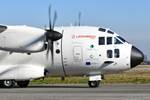HERWINGT project to design novel composite wing configuration for future regional aircraft
Pioneered wing architecture, more integrated systems and new material technologies are being explored for 20% weight reduction, 50% fuel burn reduction and to enable a hybrid-electrical use case.
Source | HERWINGT
FIDAMC (Madrid, Spain), a center of excellence for research, development and innovation in composite material technologies, has announced its participation in the European “Hybrid Electric Regional Wing Integration Novel Green Technologies” (HERWINGT) project, which began in January 2023 and runs until end of 2025. Partly funded by the European Union’s Clean Aviation program and led by Airbus Defense and Space (ADS), this project aims to design and build a wing that will enable aircraft to reduce their fuel consumption by 15% and reduce their weight by 20% compared to current regional turboprop models.
To achieve this, the 26-member consortium from academic and industry is working to narrow down its preferred architecture. So far, the team has agreed on a strut-braced, high-aspect-ratio composite wing — rather than a traditional cantilevered design — with morphing leading and trailing edges, though final decisions are expected by the end of this year. Sebastian Pellicer Sotomayor, project coordinator and member of the chief engineering R&T team at ADS noted in an interview that this preferred configuration has been selected over other options because of its ability to balance aerodynamic penalties and structural benefits. In this same interview, Pellicer does not specify the span of the new wing “but points out that it will be longer than the ATR 72-600’s 27 meters (89 feet).”
FIDAMC reports that the project is making steady progress and reaching crucial milestones. Preliminary design activities for multiple wing components — including the torsion box, center box, outer wing box, and leading and trailing edges — are scheduled to be completed by September, followed by a critical design review phase toward the end of this year. These demonstrators will be key to validating new technologies in wind tunnels and ground tests.
Among the most relevant technological advances is the development of morphing surfaces designed by the Politecnico di Milano and the Technical University of Delft. These surfaces are said to enable automatic changes in wing geometry without the need for hinge lines, improving laminar flow and reducing aerodynamic drag. This technology could be an essential component in building more efficient and sustainable aircraft in the future.
According to FlightGlobal.com, the HERWINGT project is working closely with other projects including HERFUSE for the fuselage, HE-ART for the propulsion system, HECATE for the electrical distribution system and HERA for the whole aircraft architecture. HERWINGT also pulls from the OUTCOME project, which demonstrated an out-of-autoclave, one-shot process for a wingbox cover with integrated stringers for regional aircraft.
For more details, read FlightGlobal.com’s interview with Pellicer here.
Related Content
-
Plant tour: Albany Engineered Composites, Rochester, N.H., U.S.
Efficient, high-quality, well-controlled composites manufacturing at volume is the mantra for this 3D weaving specialist.
-
A new era for ceramic matrix composites
CMC is expanding, with new fiber production in Europe, faster processes and higher temperature materials enabling applications for industry, hypersonics and New Space.
-
Plant tour: Joby Aviation, Marina, Calif., U.S.
As the advanced air mobility market begins to take shape, market leader Joby Aviation works to industrialize composites manufacturing for its first-generation, composites-intensive, all-electric air taxi.

















